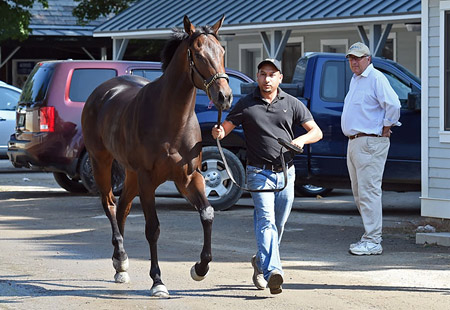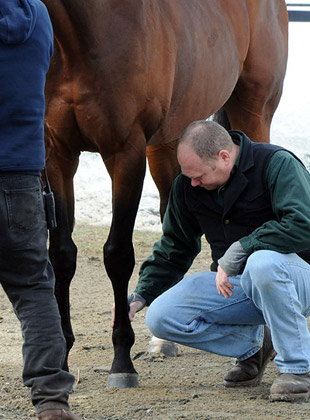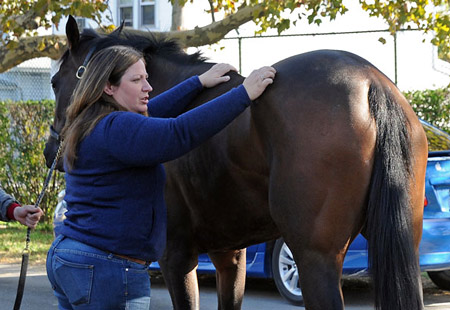Equine Veterinary Health Services

Equine Lameness Evaluations
Lameness describes a structural or functional disorder of the limbs or spinal column that can be observed while the horse is moving and/or standing. The most common causes of lameness are trauma or infection. Should your horse exhibit indications of lameness, we can provide comprehensive lameness evaluations to determine the cause and solution. Evaluations include a thorough history, physical exam, flexion tests and movement observation. Additional diagnostics may include nerve and/or joint blocks, radiographs, ultrasonography, neurological exam and under saddle observation.
Once the location, nature and extent of the problem is determined by the veterinarian, we will recommend a course of treatment to help heal your horse and allow him or her to return to regular activity. We offer a range of treatments, including (but not limited to):
- Stem Cell Therapy
- Therapeutic Joint and Tendon Sheath Injections
- Shockwave Therapy
- Acupuncture
- Chiropractic

The key to solving your horse's lameness is often a methodical approach, which allows us to slowly eliminate possible causes. All of the equine veterinarians at TFB Equine have a great deal of experience with lameness, and have established protocols that help them accurately determine the root of your horse's problem as efficiently as possible.
Internal Medicine
Even with regular, comprehensive preventive equine veterinary care, your horse can become sick or suffer an injury. The veterinarians at TFB Equine have extensive experience in the non-surgical treatment of diseases that can affect your horse's internal organs and body systems.
TFB Equine's medical services for your horse include diagnosis, management and treatment of:
- Lameness
- Neurologic disorders
- Respiratory diseases
- Dermatologic conditions
Equine Surgery
TFB Equine veterinarians offer stall side surgeries such as routine castrations, myectomies for displacement of the soft palate and laceration repair, among others.
Equine Acupuncture
According to ancient Chinese medical philosophy, disease is the result of an imbalance of energy in the body. Acupuncture is believed to balance this energy by affecting certain physiological changes with the insertion of needles at specific locations, and thereby assist the body to heal itself. Acupuncture has been used in veterinary practice in China for at 3,000 years to treat many conditions. Acupuncture can stimulate nerves, increase blood circulation, relieve muscle spasm, and cause the release of hormones such as endorphins and cortisol, all of which have positive healing effects on the body.
Most equine veterinary acupuncturists use a combination of techniques to stimulate acupuncture points. Acupuncture is a very safe medical procedure when administered by a qualified practitioner. Most animals are comfortable with acupuncture therapy and become very relaxed during treatment.
Acupuncture has been used successfully to treat many acute and chronic conditions including, musculoskeletal problems, such as muscle soreness and back pain, neurological disorders including laryngeal hemiplegia, gastrointestinal disorders such as diarrhea or impactions, and other chronic conditions. Clinical trials indicate acupuncture may also be effective in performance enhancement and prevention of disease.
Equine Chiropractic Care

The basis of chiropractic therapy is that proper function of the musculoskeletal system allows the rest of the body, particularly the nervous system, to function properly as well. When this happens, the body is able to heal itself, fight disease, and maintain optimal health.
A chiropractic adjustment is applied to a vertebral subluxation complex, where the joint between two vertebrae has lost its flexibility. The goal of the adjustment is to restore normal mobility to the joint, thereby stimulating normal neurological reflexes and reducing pain and muscle spasm.
Chiropractic should be considered for any horse that suffers from neck or back pain, joint stiffness, poor performance, or an altered gait that is not associated with overt lameness. Chiropractic care is appropriate in the maintenance of joint and spinal health which is important for the equine athlete.
Shockwave Therapy
Extracorporeal shockwave therapy, more commonly known as just "shockwave," has been clinically shown to be helpful in the healing of a wide range of equine orthopedic conditions. The veterinarians and staff at TFB Equine are proud to offer this state-of-the-art treatment to patients.
Shockwaves are focused, high-energy sound waves—generated by compressed air—that travel through tissues via contact with the hand piece. These waves affect the soft tissue and bone structures in a targeted area by activating the horse's natural repair mechanisms (i.e. increasing circulation, stimulating bone cells and energizing neurotransmitters).
Shockwave has been used successfully to treat many ailments in horses, such as:
- Suspensory ligament desmitis and other ligament damages
- Chronic muscle soreness
- Sacro-iliac pain
- Tendon injuries
- Hock arthritis
- Stress fractures and non-union fractures
- Splints
- Sesamoid bone damage
Before the veterinarian can perform shockwave therapy, it is important that your horse have a firm diagnosis. A lameness examination and workup is generally required prior to treatment. Shockwave therapy is performed on a mildly sedated standing horse, and treatment usually takes 20 minutes or less. Treatments are usually administered in a series at 2-3 week intervals.
